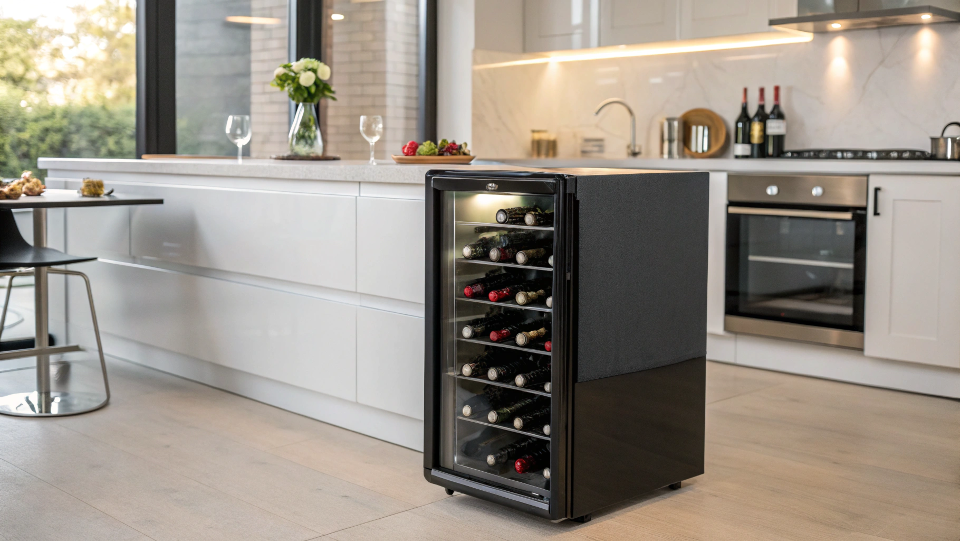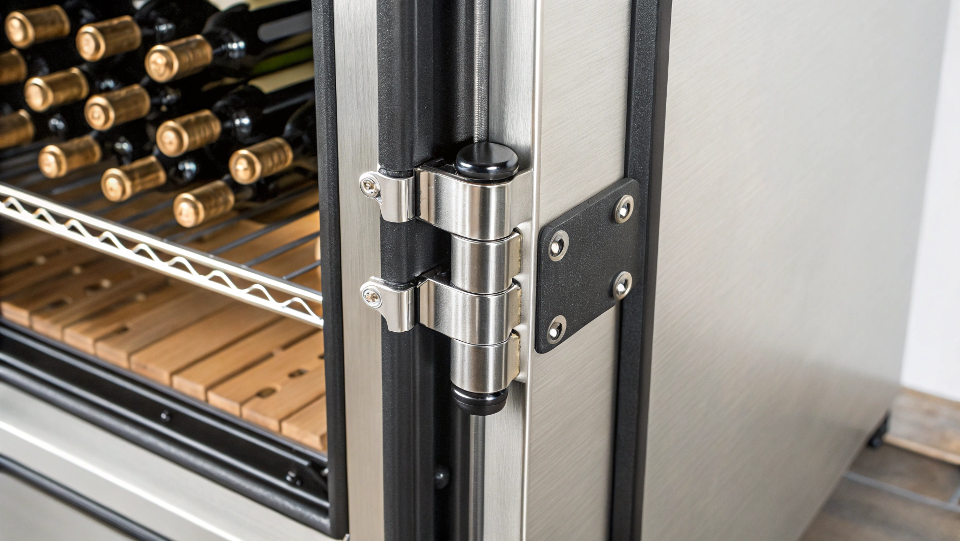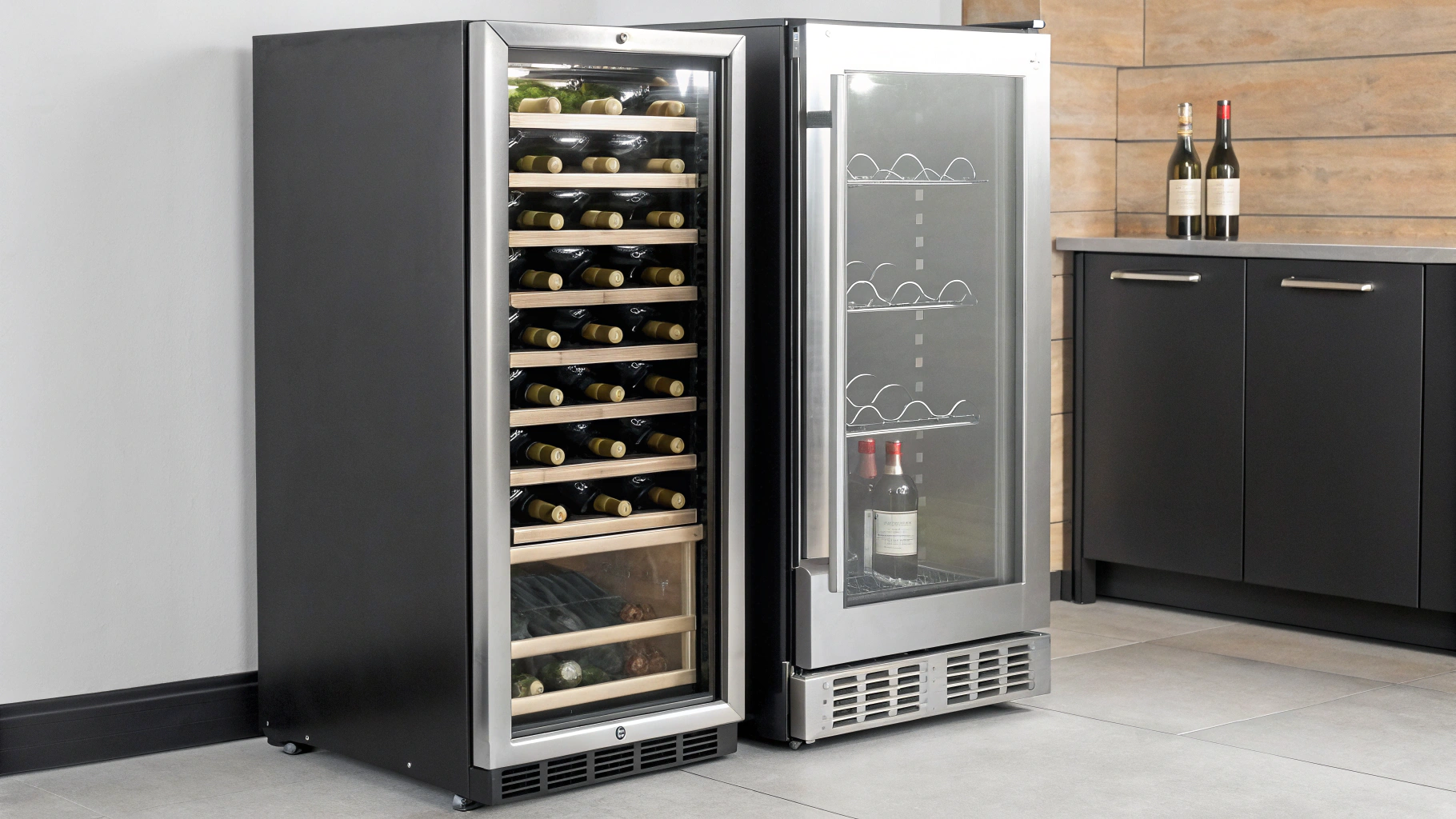Choosing the wrong wine cooler can ruin your valuable wine collection. You worry about inconsistent temperatures and limited space. Understand the key differences to invest wisely in the right unit.
The main differences are capacity, cooling power, durability, and price. Commercial coolers are built for high-volume, frequent use with robust systems. Home coolers prioritize aesthetics and quieter operation for residential settings, offering smaller capacities.
I've seen many business owners get this wrong at the start. They might think a stylish home unit is enough for their small cafe, or overspend on a massive commercial one they don't really need. It all comes down to understanding your true purpose for the cooler. Let's break down the details so you can make the right choice for your business or your home. We will start with the most obvious difference: how they look and how much they can hold.
Does Size and Design Really Matter for Your Business?
A bulky, ugly cooler can ruin a carefully designed space. You want equipment that fits your brand's style but still meets your storage needs. Let's explore how design impacts function.
Yes, it matters a lot. Home coolers are designed to be stylish and compact, fitting into kitchen or living room decor. Commercial coolers prioritize maximum bottle capacity and function over form, often featuring sturdy, utilitarian designs.

When I walk through my factory, the difference is night and day. The production line for home units focuses on finish, color, and sleek dimensions. The line for commercial units is all about stainless steel, strong frames, and maximizing every inch of interior space. For a business owner like Alex, who is building a brand around retro appliances, the design is part of the product's story. But function can never be ignored.
Aesthetics vs. Practicality
Home wine coolers are treated like furniture. They come in various colors and finishes, with features like wooden shelving and soft interior lighting to showcase a collection beautifully. Commercial units are workhorses. Their design is simple, focused on durability and easy cleaning. The shelving is typically sturdy metal wire that can handle heavy bottles and frequent use without breaking.
From Small Collections to Large Inventories
The most basic difference is how many bottles they hold. A home user might be happy with a 24-bottle cooler. A restaurant or wine shop needs to store hundreds of bottles.
| Feature | Home Wine Cooler | Commercial Wine Cooler |
|---|---|---|
| Primary Goal | Aesthetic integration & personal use | High-volume storage & business use |
| Capacity | 12 - 100 bottles | 100 - 500+ bottles |
| Design Focus | Stylish, compact, variety of finishes | Utilitarian, durable, easy access |
| Placement | Kitchen, living room, home bar | Restaurants, bars, retail stores |
A client once bought several beautiful home coolers for his small cafe. They looked great, but he couldn't keep up with demand. The staff was constantly restocking, and the pretty wooden shelves weren't built for that much wear and tear. He eventually switched to a single, larger commercial unit.
Is a More Powerful Cooling System Always the Better Choice?
Unstable temperatures can spoil expensive wine inventory fast. You might be afraid a weak cooler won't handle frequent door openings in a busy setting. Let's look at the technology inside.
Not always. Powerful compressor systems in commercial coolers maintain stable temperatures despite frequent use, which is essential for business. Quieter thermoelectric systems in many home coolers are great for quiet spaces but struggle with temperature recovery and warm rooms.
The cooling system is the heart of the wine cooler. Choosing the wrong one is like putting the wrong engine in a car. From my experience manufacturing both types, the choice between technologies is critical and depends entirely on how the cooler will be used. One system provides raw power, while the other offers silent operation.
Compressor Cooling: The Commercial Standard
This technology works just like a standard kitchen refrigerator. A compressor circulates a refrigerant to cool the air inside. It's powerful, can handle high ambient temperatures, and recovers its set temperature quickly after the door has been opened. This is why it's the standard for commercial units that are opened constantly in a busy restaurant or store. The downsides are that it can be slightly noisier and cause small vibrations.
Thermoelectric Cooling: The Quiet Alternative
This system uses a principle called the Peltier effect to transfer heat from inside the cooler to the outside. It has no moving parts besides a small fan, so it's very quiet and has zero vibrations. This is ideal for a home setting where noise is a concern, and it's great for aging wines as there's no vibration to disturb the sediment. However, it's less powerful and its performance can be affected by the room's temperature. It's not suitable for a hot garage or a busy commercial kitchen.
| Technology | Best For | Pros | Cons |
|---|---|---|---|
| Compressor | Commercial settings, large collections | Powerful, stable temp, fast recovery | Can be noisier, slight vibrations |
| Thermoelectric | Small home collections, quiet spaces | Very quiet, no vibrations | Less powerful, struggles in warm rooms |
For a business selling wine, a compressor cooler is almost always necessary. Imagine a staff member opens the door, and it takes 30 minutes for the temperature to drop back to a safe level. That's a huge risk to your inventory.
Why Should You Pay More for Commercial-Grade Durability?
Your equipment keeps breaking down under heavy use. You are tired of replacing units that can't handle the demands of a commercial environment. Learn why durability is a smart investment.
You pay more for longevity and reliability. Commercial coolers use heavy-duty materials like stainless steel and robust components built for constant door openings. This higher initial cost prevents frequent replacements and lost business in the long run.

When we source materials for our factory, the components for commercial models are in a different class. We're talking thicker steel, stronger hinges, and more robust compressors. You're not just paying for a brand name; you're paying for parts that are designed to last through years of demanding, non-stop use. This isn't an expense; it's an investment in your business's smooth operation.
Materials and Construction
A home wine cooler might have a plastic interior liner and shelves made of wood or light-gauge wire. They look nice but are not designed for heavy, constant loading and unloading. A commercial cooler often uses a full stainless steel interior and exterior. This isn't just for looks; it's for hygiene and strength. The metal shelves are reinforced to hold the maximum number of heavy bottles without bending. The doors and hinges are built to withstand being opened hundreds of times a day.
Lifespan and Compliance
Beyond just materials, commercial units are engineered for a much longer operational life. They are expected to run 24/7 for a decade or more. Also, in many countries, commercial equipment must meet specific health and safety standards, like NSF certification. This ensures the unit is easy to clean and safe for a food and beverage environment. Home units do not need to meet these strict commercial codes. For a brand owner like Alex, selling a durable product means fewer warranty claims and happier customers who trust his brand.
| Aspect | Home Wine Cooler | Commercial Wine Cooler |
|---|---|---|
| Construction | Lighter materials, aesthetic focus | Heavy-duty steel, reinforced parts |
| Shelving | Wood or light wire for looks | Sturdy metal for high load capacity |
| Lifespan | 3-7 years | 10+ years with proper maintenance |
| Regulations | Standard consumer electronics safety | Often requires commercial certification (e.g., NSF) |
Conclusion
Choosing between home and commercial wine coolers depends entirely on your needs. Assess your capacity, daily usage, and budget to find the perfect fit for your personal collection or business.

